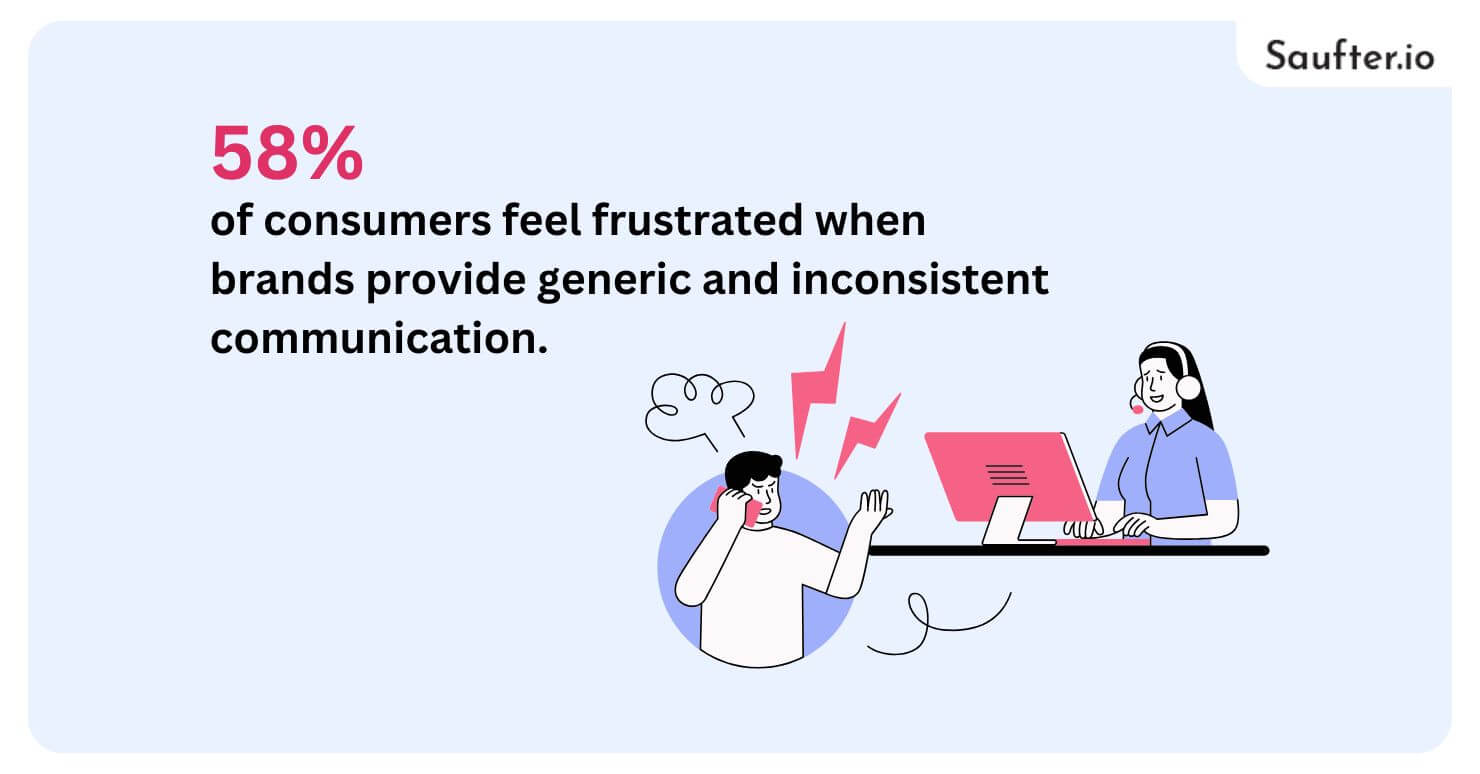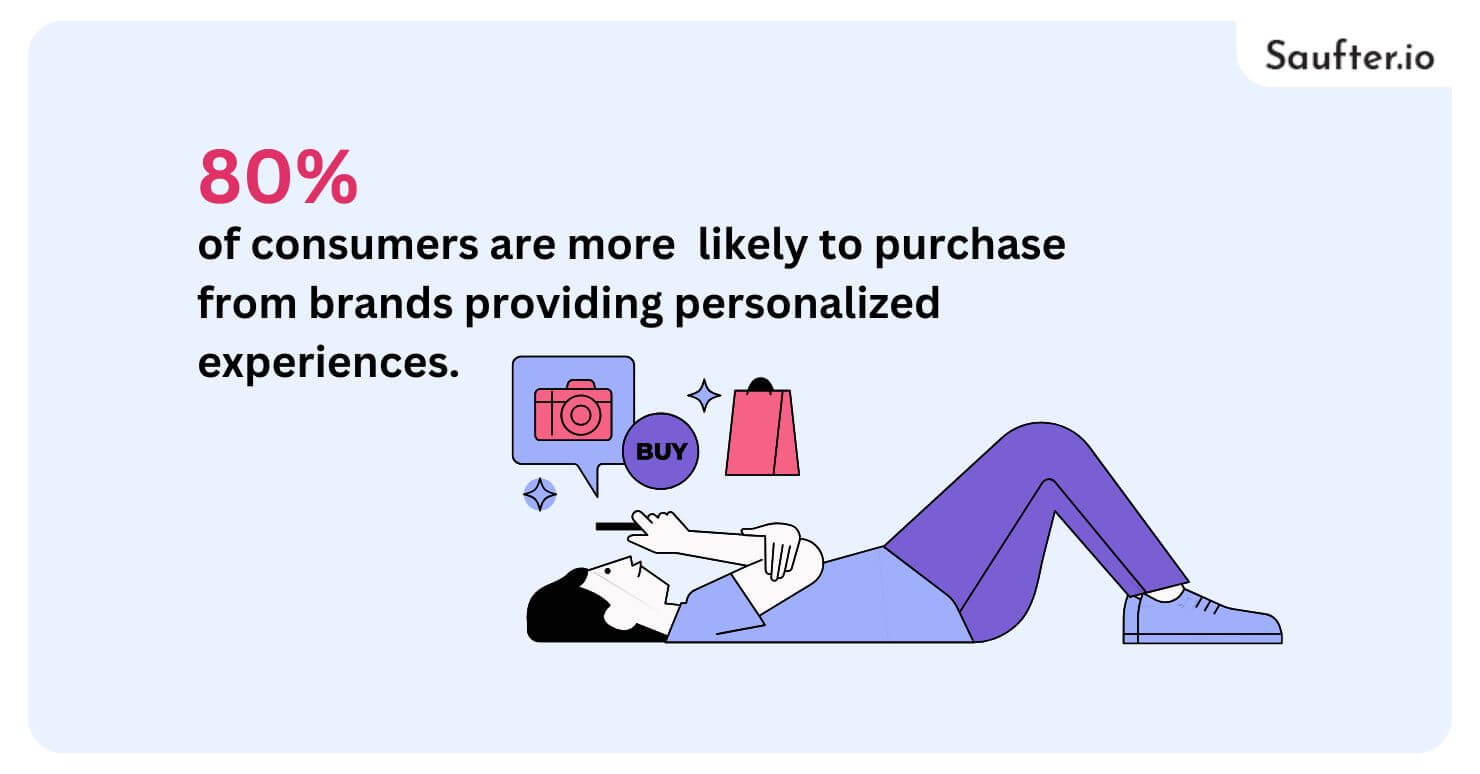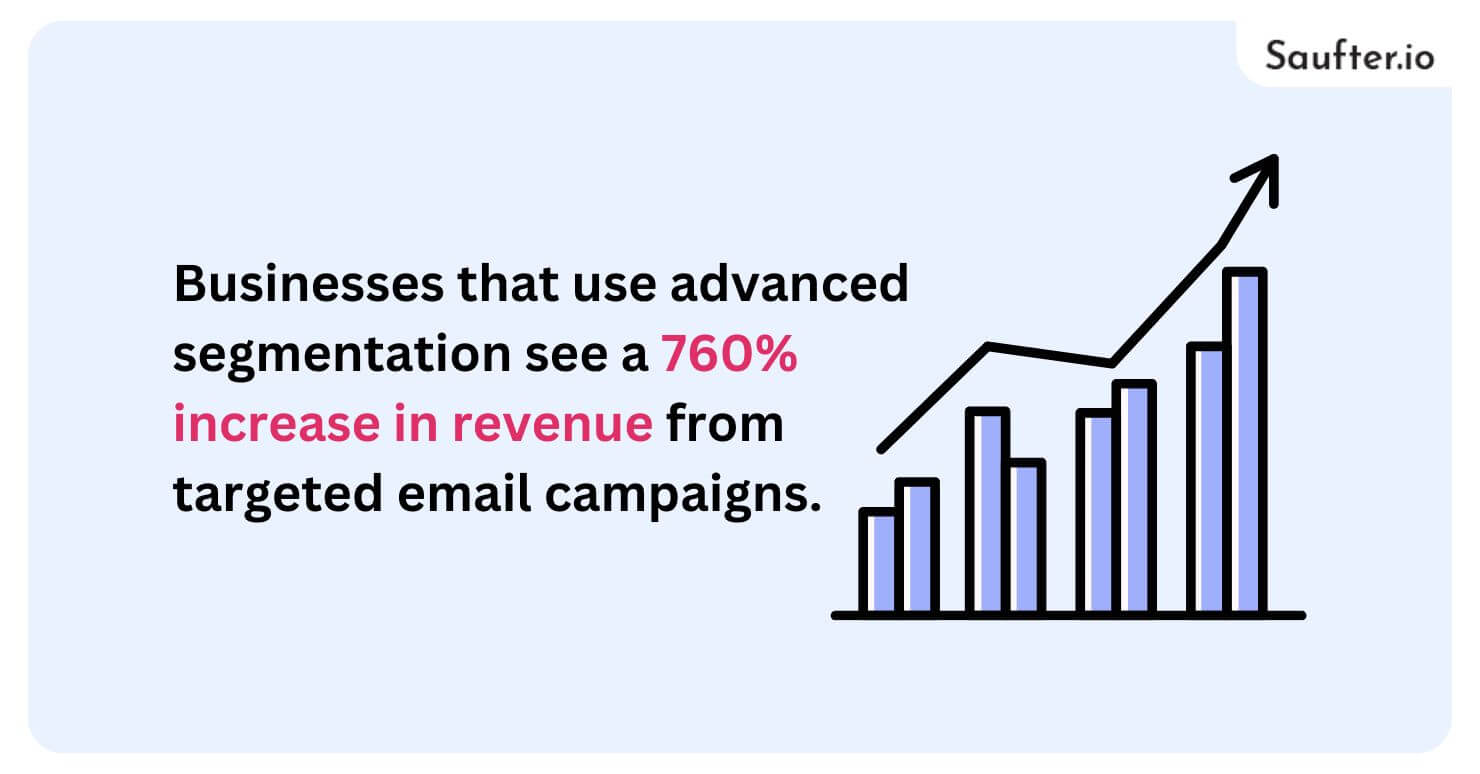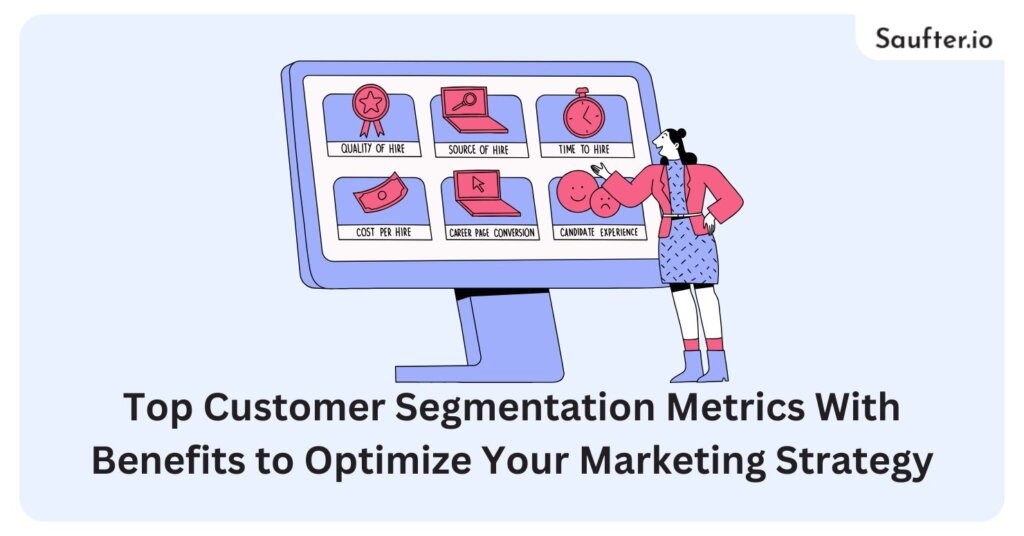Last Updated: December 2025
Leveraging customer segmentation metrics is crucial for businesses aiming to maximize their marketing impact. According to a study by Bain & Company, companies that excel in segmentation experience a 10% higher profit growth than those that don’t. By using the right customer segmentation metrics, businesses can create personalized campaigns, improve customer engagement, and increase conversion rates.
In this article, we’ll explore the top four customer segmentation metrics, their benefits, and how they can help you optimize your marketing strategy for better results.
Table of Contents
Customer Segmentation Analysis
eCommerce Customer Segmentation
Key Benefits of Customer Segmentation
Why Do Customer Segmentation Metrics Matter?
4 Essential Customer Segmentation Metrics to Track
Customer Segmentation Strategy Examples
Saufter: Best Automated Customer Segmentation and Email Campaign Software
Customer Segmentation Analysis
The customer segmentation analysis process improves customer engagement, retention, and profitability. These insights help businesses segment customers, discover patterns, and refine marketing efforts.
1. Collect and Organize Data
Gather customer data from sources like CRM systems, social media, and website analytics. Include demographics, geographic details, and behavioral patterns. Ensure data accuracy by removing outdated or irrelevant information.
2. Define Segmentation Criteria
Select relevant segmentation criteria, including demographics (age, income), geography, behavior (purchase habits), and psychographics (lifestyle, values). B2B companies will also focus on firmographics, such as company size and company type.
3. Analyze Customer Patterns and Trends
Determine trends in all the segments, like shopping habits or level of engagement. Knowledge of such patterns is used to fine-tune marketing messages and to improve product offerings.
4. Evaluate Business Impact
Evaluate the impact of each segment on revenue and retention. Concentrate on segments with a high potential to generate value while spending on efforts that curb churn in vulnerable cohorts.
5. Apply Insights to Marketing Strategies
Segmentation data can help you customise your marketing, optimize your pricing, and generally refine your customer journeys. When they receive the right messaging and promotions, engagement increases and ROI is maximized.
By leveraging comprehensive segmentation analysis, businesses can better inform their decision-making, improve relationships with customers, and experience long-term success.
eCommerce Customer Segmentation
Historically, there have been four main types of market segmentation: demographic, psychographic, geographic, and behavioral. But today, modern marketers have large amounts of data on their screens, which opens the door for micro-segments, allowing them to deliver highly personalized experiences.

A survey found that 58% of consumers feel frustrated when brands provide generic and inconsistent communication. But marketers can leverage plenty of customer characteristics to power their strategies, such as:
- Products purchased
- Email click-throughs
- Pages/content viewed
- Geolocation
- Email opens
- Demographics
- Previous visit behavior
- Customer journey stage
By tracking on-site behaviors and stages of the customer journey, businesses can target even more segmented audiences and further optimize their marketing efforts to increase customer engagement.
Key Benefits of Customer Segmentation
Do you know that marketing segmentation can boost conversion rates by up to 200%? Market segmentation can greatly improve your marketing approach:

- Personalized Communication – It allows targeted communication with specific customer segments, enhancing brand loyalty.
- Deeper Customer Insights – This also helps in analyzing the purchasing behaviors of both prospective and existing customers.
- Enhanced Customer Experience – Enables businesses to customize goods, services and interactions through psychographics and other segmentation approaches.
- Improved ROI & Conversion Rates – By optimizing marketing strategies, engagement, conversion rates, and revenue, significantly increase.
In essence, customer segmentation provides the data-driven insights needed to refine marketing strategies, enhance customer relationships, and drive business growth.
Why Do Customer Segmentation Metrics Matter?
Knowing and collecting customer segmentation metrics improves retention rates, lowers churn, and grows your business overall. These metrics influence:
- Marketing strategies (personalized messaging and campaigns)
- Upselling and cross-selling opportunities (targeting the right customers)
- Risk mitigation (predicting churn and taking preventive actions)
Gone are the days of one-size-fits-all marketing approaches. Businesses need to offer personalized experiences to different sets of customers to improve the customer experience and grow their customer base.
This is something that is only possible with deep customer segmentation insights.
4 Essential Customer Segmentation Metrics to Track
These four advanced segmentation metrics can, therefore, improve your knowledge of user incentives and give you a competitive advantage in practicing your marketing strategies, although traditional segmentation methods will still provide useful insights.
1) Cohort Segmentation
Cohorts are different from traditional segmentation (e.g., demographics, psychographics) as Cohort segmentation groups customers based on when they first interacted with you (e.g. when they first visited your website or made a purchase).
When businesses consider these time-based cohort groups, they can analyze behaviour:
- Explore the trends and patterns over time.
- Compare cohorts to measure marketing effectiveness.
- Anticipate how customers will act in the future, hence improving retention.
2) User Churn Segmentation
The churn rate indicates the proportion of customers that discontinue using your product within a specific period. Analytics of fluctuation rates in various segments allow businesses to:
- Pinpoint high-risk customer categories.
- Recognize why churn occurs and solve your problems.
- Doing preventive measures (e.g., loyalty programs, special offers) to lower the chance of losing customers.
3) Customer Lifetime Value (LTV) Segmentation
LTV estimates the total revenue that you will bring to a business throughout your relationship. Customer segmentation by LTV allows for:
- Better-targeted messaging — VIP customers get premium offers, and low LTV customers get promotions to increase spending.
- Resource allocation — Companies can allocate resources toward retaining high-value customers.
- Revenue forecasting — Knowing LTV makes long-term planning much easier.
4) Monthly Recurring Revenue (MRR) Segmentation
In the case of SaaS and subscription-based businesses, MRR is essential because it reflects predictable revenue streams. Identifying and classifying customers based on MRR can help organizations to:
- Determining high-value clients that generate consistent revenue.
- Target marketing and retention tactics towards your most profitable customer groups.
- Optimize pricing models to encourage long-term subscriptions.
Customer Segmentation Strategy Examples
Here is how successful brands drive engagement and revenue through segmentation. Amazon uses purchases to suggest products, and Netflix tailors content to viewing habits.

In fact, 80% of consumers are more likely to purchase from brands providing personalized experiences.
New Customers (Customer Lifecycle Segmentation)
Subscription models divide their customers by lifecycle and offer deals and trials to appeal to new users.
HBO Max is successfully leveraging this strategy to offer a 40% discount on its annual ad-free plans to target prospective subscribers who may be sceptical about monthly subscriptions. It not only fosters long-term commitment but also fights churn and provides sustained customer relationships.
Repeat Customers and Brand Loyalty (Customer Lifecycle Segmentation)
Sephora’s Beauty Insider loyalty program is an excellent case of customer lifecycle segmentation. The company classifies customers by their purchasing history and preferences, rewarding their loyalty with gifts, discounts, exclusive offers and free samples.
Inducements to buy more goods can include personal shop-by segments and special privileges that help drive members’ connections with the brand.
By continuously improving the customer experience, keeping up with beauty trends, and listening to feedback, Sephora gets customers coming back, fighting for long-term retention and growth.
Website Activity (Technographic Segmentation)
Customers can also be segmented based on their website interactions. This broad approach includes various behaviors, allowing for multiple segmentation strategies.
Analytics data allows businesses to segment users by the pages viewed, clickthroughs on features like CTAs and forms, the amount of time spent on each page, and actions, including adding products to the cart.
Such insights allow businesses to fine-tune marketing strategies and improve the customer journey.
Traffic Source (Channel Segmentation)
Having a segmented customer base by traffic source indicates how customers arrive at a website, whether through search engines, email newsletters, social media, etc.
If users enter the site predominantly from social media ads or organic search, for example, businesses can optimize these for better conversions. Knowing where your traffic comes from helps you make better marketing decisions and acquire customers more effectively.
Saufter: Best Automated Customer Segmentation and Email Campaign Software
Saufter is a powerful tool designed to automate customer segmentation and optimize email marketing campaigns. It leverages AI-driven insights to track user behavior, engagement patterns, and competitor strategies, ensuring businesses deliver highly personalized email content.

For SaaS companies, Saufter identifies key feature usage during free trials, intervenes with in-app and email prompts to prevent drop-offs, and customizes newsletters based on user attributes.
E-commerce brands benefit from automated campaigns triggered by cart abandonment, purchase history, and browsing behavior, leading to higher conversions.
By studying engagement across various touchpoints, Saufter suggests ideal customer cohorts and tailors messaging for maximum deliverability.
With its intelligent automation, businesses can increase retention, reduce churn, and drive meaningful customer interactions effortlessly.
Conclusion
Utilizing customer segmentation metrics can significantly improve marketing strategies and customer retention. In fact, businesses that use advanced segmentation see a 760% increase in revenue from targeted email campaigns.

Tracking key customer segmentation metrics such as cohort analysis, churn rate, LTV, and MRR helps businesses create highly personalized experiences that drive engagement and loyalty.
With AI-powered platforms like Saufter, companies can automate segmentation and optimize email marketing efforts. From analyzing user behavior to generating AI-driven campaign suggestions, Saufter helps businesses leverage customer segmentation metrics effectively to maximize growth and customer satisfaction.
















